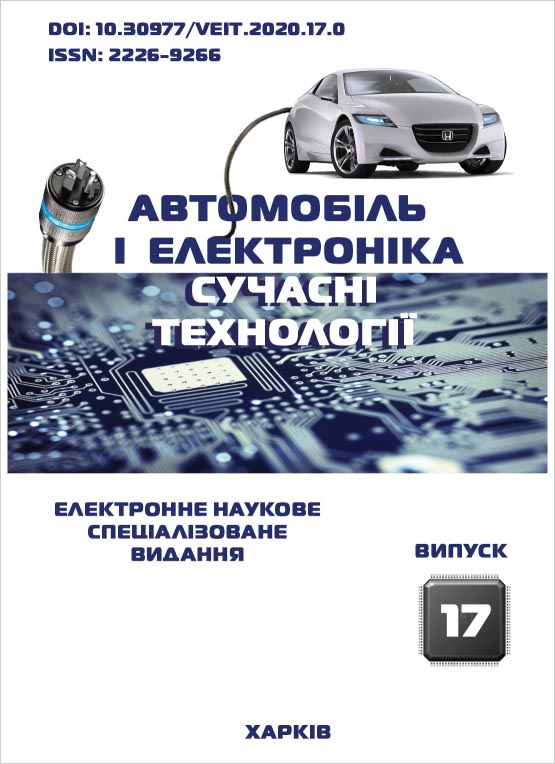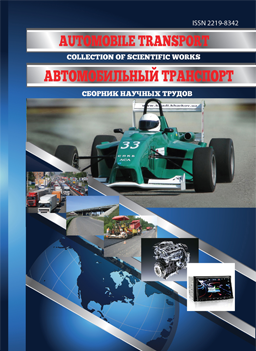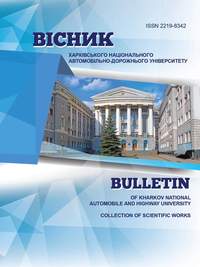Development of intelligent vehicle systems based on CAN network
DOI:
https://doi.org/10.30977/VEIT.2020.18.76Abstract
The paper analyzes the characteristics of CAN network (Controller Area Network) and compares them with the characteristics of known electronic interfaces, which are used for the development of traffic control systems. Such interfaces were considered as: RS-423, RS-422 and RS-232. It should be noted that they work much faster and transmit control signals directly to the executive bodies. It is shown that despite the lower speed, the advantages of the CAN network are high protection against external interference, reliability and error-free operation. These advantages are manifested in networks with many nodes that work simultaneously and interact with each other. The main advantage of CAN is the ability to provide adaptive management of network nodes when they exchange information, process it on on-board computers and take into account the current situation as it develops at a particular time. Using the CAN network, a system design of some systems has been developed, which are relevant for implementation on cars on urban electric vehicles. The project of adaptive lighting system developed in accordance with the recommendations of NECE is: Transport Regulation No. 123, Uniform provisions concerning the approval of adaptive front-lighting systems (AFS). This system implements one of the most advanced algorithms of AFS, namely the pre-inspection algorithm, which takes into account the properties of the driver's eyes to assess the traffic situation on the road. The option of implementing an automated toll collection system in a trolleybus, which includes cash registers, validators, number of passenger sensors and a passenger alert system, was also considered. It is proposed to perform an adaptive lighting system and an automated fare collection system on one CAN bus with a speed of 1 Mbit/s, as one of them works while driving on the route, and the other mainly during vehicle stops. The system of energy saving for the means of city ground passenger electric transport at the expense of a choice of optimum modes of movement is also developed. The system works on an advanced electronic model for calculating motion characteristics. It includes a computer with the appropriate software, an electronic route map, traffic schedules, and a satellite orientation system. During the movement the coordinates and speed of the vehicle are determined and according to the program the mode of movement from the current point to the stopping point is calculated. As a result of processing the results and comparing them with the schedule, the driver is recommended to choose the mode of movement with the lowest energy consumption. A state patent has been obtained for the proposed system.
Keywords: CAN network, intelligent system, car, trolleybus, adaptive lighting, energy saving, interface.
References
Mashyna chasu: Test-drayv Tesla Model X. URL: https://auto.ria.com/uk/news/test-drive/229529 (accessed 20.09.20).
Dahou H., Gouri R. El. Alareqi M. and others. Design and Implementation Intelligent Adaptive Front-lighting System of Automobile using Digital Technology on Arduino board. International Journal of Electrical and Computer Engineering (IJECE). 2018. 8 (1). 521-529.
Petin V.A. (2014) Proyekty s ispol'zovaniyem kont-rollera Arduino. [Projects using an Arduino controller]. BKHV-Peterburg. [in Russian]
Entsiklopediya ASU TP: 2 Promyshlennyye seti i interfeysy: 2.3 Interfeysy RS-485, RS-422 I RS-232. [Encyclopedia of APCS: 2 Industrial networks and interfaces: 2.3 RS-485, RS-422 AND RS-232 interfaces]. URL: https://www.bookasutp.ru/Chapter2_3.aspx (accessed 09.09.20). [in Russian]
Karpenko Ye. Obzor. Promyshlennyye seti. Vozmozhnosti CAN protokola. [Overview. Industrial networks. CAN protocol capabilities]. URL: http://www.cta.ru/cms/f/326789.pdf (accessed 09.09.20). [in Russian]
ISO/IEC 7498-1:1994 Information technology — Open Systems Interconnection Basic Reference Model: The Basic Model. International Standard ISO/IEC 7498-1:1994
ISO 11898-1:2003(E), Road vehicles – Controller area network (CAN) – Part 1: Data link layer and physical signaling,. URL: International Standard ISO 11898-1:2003(E). (accessed 20.09.20).
Soroka K., Kharchenko V., Plyuhin V. (2020) Development of CAN network with improved parameters for adaptive car front lighting system. Skhidno-Yevropeysʹkyy zhurnal peredovykh tekhnolohiy (EEJET). 4, 9 (106). 24 – 33.
Soroka K. Kharchenko V., Shpyka N. (2018) Vehicle lighting equipment and control methods for an adaptive front-lighting system. Mizhnarodnyi zhurnal «Svitlotekhnika ta elektroenerhetyka», KhNUMH. 52 (02). 63-67.
Lifu Li., Mingjun and Jinyong Z. (2015) The bending mode control method of AFS L system based on preview control, International Journal on Smart Sensing and Intelligent Systems. 8 (1). 637-657.
Capasso A., Lamedica F.M., Gatta and others. (2016) Individual driving style impact on traction energy consumption in railway lines: A simulation model Power Electronics, Electrical Drives. Automation and Motion. 2016 International Symposium. Anacapri, Italy. 665-670.
Soroka K.O., Lychov D.O. (2015) Zmistovna modelʹ ta rivnyannya rukhu elektrychnoho transportu. [Meaningful model and equation of motion of electric transport]. Visnyk DNUZT. 3 (57). 97-106.
Soroka K. O. Lychov D.O. (2016) Patent Ukrayiny № 110877 MPK B60W 50/00; B60W 50/0825. ystema avtomatyzovanoho vyboru shvydkisnoho rezhymu rukhu nazemnoho elektrychnoho transportnoho zasobu.
Downloads
Published
How to Cite
Issue
Section
License
Copyright (c) 2021 Костянтин Олексійович Сорока

This work is licensed under a Creative Commons Attribution 4.0 International License.
Автори, які публікуються у цьому журналі, погоджуються з наступними умовами:
1. Автори залишають за собою право на авторство своєї роботи та передають журналу право першої публікації цієї роботи на умовах ліцензії Creative Commons Attribution License, котра дозволяє іншим особам вільно розповсюджувати опубліковану роботу з обов'язковим посиланням на авторів оригінальної роботи та першу публікацію роботи у цьому журналі.
2. Автори мають право укладати самостійні додаткові угоди щодо неексклюзивного розповсюдження роботи у тому вигляді, в якому вона була опублікована цим журналом (наприклад, розміщувати роботу в електронному сховищі установи або публікувати у складі монографії), за умови збереження посилання на першу публікацію роботи у цьому журналі.
3. Політика журналу дозволяє і заохочує розміщення авторами в мережі Інтернет (наприклад, у сховищах установ або на особистих веб-сайтах) рукопису роботи, як до подання цього рукопису до редакції, так і під час його редакційного опрацювання, оскільки це сприяє виникненню продуктивної наукової дискусії та позитивно позначається на оперативності та динаміці цитування опублікованої роботи.








